
Great Smoky Mountains National Park is a national park of the United States in the southeast, with parts in North Carolina and Tennessee. The park straddles the ridgeline of the Great Smoky Mountains, part of the Blue Ridge Mountains, which are a division of the larger Appalachian Mountain chain. The park contains some of the highest mountains in eastern North America, including Kuwohi, Mount Guyot, and Mount Le Conte. The border between the two states runs northeast to southwest through the center of the park. The Appalachian Trail passes through the center of the park on its route from Georgia to Maine. With 13 million visitors in 2023, the Great Smoky Mountains National Park is the most visited national park in the United States.

Zanclognatha is a genus of litter moths of the family Erebidae. The genus was erected by Julius Lederer in 1857.
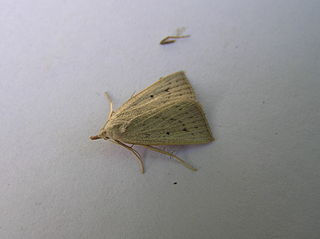
Macrochilo is a genus of litter moths of the family Erebidae. They are found in North America, Europe, and Madagascar. The genus was erected by Jacob Hübner in 1825.

Phalaenophana is a genus of litter moths of the family Erebidae. The species was first described by Augustus Radcliffe Grote in 1873.

Tetanolita is a genus of litter moths of the family Erebidae. The genus was erected by Augustus Radcliffe Grote in 1873.
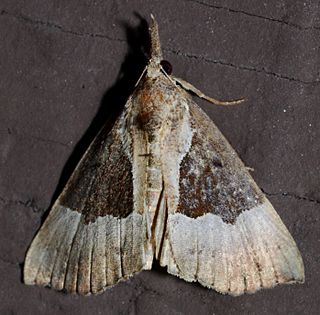
Hypena bijugalis, the dimorphic bomolocha, dimorphic hypena or toothed snout-moth, is a moth of the family Erebidae. The species was first described by Francis Walker in 1859. It is found in North America from Nova Scotia across southern Canada to Vancouver Island, south over the whole United States to Florida.

Hypena edictalis, the large bomolocha, is a moth of the family Erebidae. The species was first described by Francis Walker in 1859. It is found in North America from Quebec and Maine south to Virginia and Kentucky, west to the foothills of Alberta and the Peace River area of British Columbia.
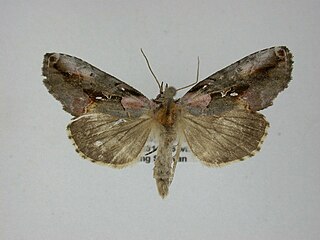
Eosphoropteryx thyatyroides, the pink-patched looper moth or pink-tinted beauty, is a moth of the family Noctuidae. The species was first described by Achille Guenée in 1852. In North America it is found from Nova Scotia and northern Ontario south to Minnesota, Michigan, Ohio and along the Appalachians from Maine to eastern Tennessee and western North Carolina; and to the west, it occurs from central Alberta and southern British Columbia, south in the Cascades to southern Oregon, and in the Rocky Mountains to northern Idaho.
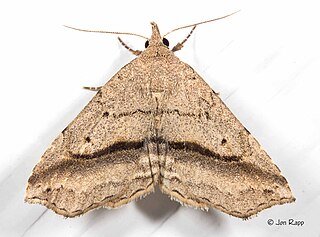
Ledaea perditalis, the buttonbush owlet or lost owlet moth, is a moth in the family Erebidae. The species was first described by Francis Walker in 1859. It is found in North America from the Great Lakes states, Quebec and northern New England, south to Florida and Texas.

Phalaenophana pyramusalis, the dark-banded owlet, is a moth of the family Erebidae. The species was first described by Francis Walker in 1859. It is found in North America from Saskatchewan to Nova Scotia, south to North Carolina and Texas.

Macrochilo orciferalis, the chocolate fan-foot or bronzy macrochilo, is a litter moth of the family Erebidae. The species was first described by Francis Walker in 1859. It is found in North America from Wisconsin to Nova Scotia, south to Florida and Texas.

Phalaenostola eumelusalis, the punctuated owlet or dark phalaenostola, is a moth of the family Erebidae. The species was first described by Francis Walker in 1859. It is found in North America from New Brunswick, North Dakota and South Dakota to Maine, south to Georgia and Iowa. In the north it is also found in Saskatchewan.
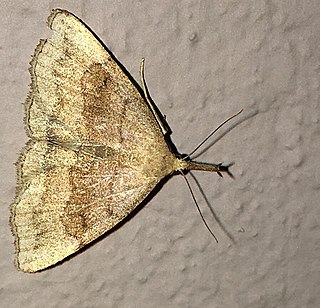
Phalaenostola metonalis, the pale phalaenostola, tufted snout or pale epidelta, is a moth of the family Erebidae. The species was first described by Francis Walker in 1859. It is found in North America from British Columbia to Newfoundland, south to North Carolina, west to Missouri.
Tetanolita borgesalis is a litter moth of the family Erebidae first described by Francis Walker in 1859. It is found in South America, including the French Antilles and Brazil.

Renia factiosalis, the dark-banded renia or sociable renia moth, is a litter moth of the family Erebidae. The species was first described by Francis Walker in 1859. It is found from southern Canada to Florida and Texas.

Renia sobrialis, the sober renia, is a litter moth of the family Erebidae. The species was first described by Francis Walker in 1859. It is found from Nova Scotia to Florida, west to Mississippi and Minnesota.
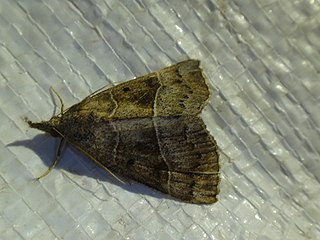
Hypena deceptalis, the deceptive hypena or deceptive bomolocha moth, is a moth of the family Erebidae. The species was first described by Francis Walker in 1859. It is found in North America from Manitoba to Quebec, south to Florida and Texas. It is absent from much of Gulf Coastal Plain though.

Gesneria centuriella is a species of moth in the family Crambidae described by Michael Denis and Ignaz Schiffermüller in 1775. It is found from Europe, east to Japan. It is also present in Greenland and northern North America.
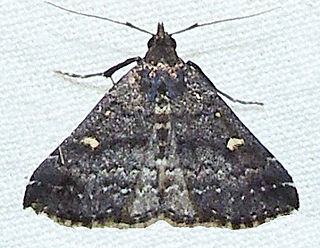
Hypenula cacuminalis, the long-horned owlet moth, is a moth of the family Erebidae. The species was first described by Francis Walker in 1859. It is found from the south-eastern United States west to Texas and Arizona.

Mastophora hutchinsoni, also known as the American bolas spider, is a species of orb weaver in the genus Mastophora. The genus is distributed extensively throughout various subtropical geographical areas including Australia, South Africa, Oriental Asia, and the Americas and is not found in Europe. The hunting behavior of adult female M. hutchinsoni is unusual because they are bolas spiders. They mimic moth pheromones to attract male moths, and female M. hutchinsoni have evolved to alter their chemical release to target different moths. They then capture their prey with a sticky drop on the end of a silk line, resembling a bolas.



















